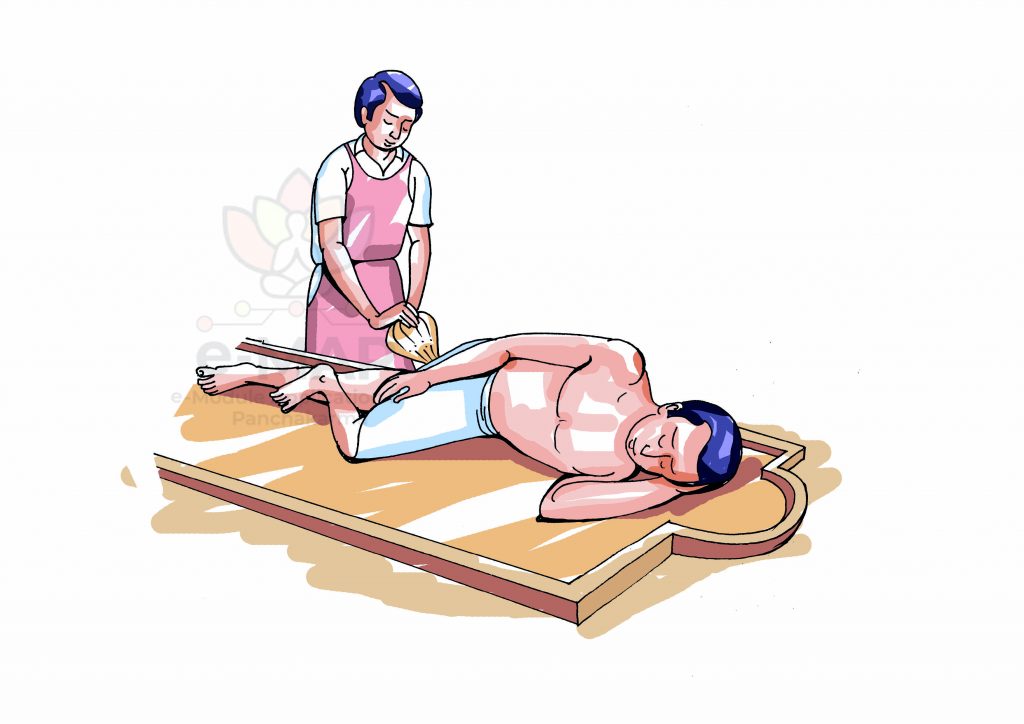
PG Module 6
BASTI KARMA

EXPLANATORY NOTES
NIRUKTI
Anuvāsana word derived from the root word ‘Vāsa’ with prefix ‘Anu’. The Basti is administered every day is called Anuvāsara.
अनुवसन्नापिनदूषयत्यनुपदवसंवादीयतेइपतअनुवासनम् [iii] (Su. Chi. 37/18)
That which doesn’t produce vitiation of Doṣa if retained in body or that which can be administered daily is called Anuvāsana.
Administration of different kinds of Sneha Dravya through the rectal route is known as Sneha Basti. Anuvāsana Basti is a type of Sneha Basti which can be used independently or in combination with Nirūha Basti as in Karma – Kāla – Yoga Basti Krama.
[i] Vachaspatya
[ii] Vachaspatya
[iii] Su. Chi 37/18
Anuvāsana Basti is classified into 3 depending on the Mātrā of the Sneha used in the Basti.
षट्पलीतुभवेच्छ्रेष्ठात्रिपलीमध्यमाभवेत् |
कनीयस्यार्धपलिका त्रिधा मात्रानुवासने || (Su. Chi. 37/4, Ḍalhaṇa commentary)
Maximum dose of Sneha Basti | 1/4th of maximum Mātrā of Nirūha Basti | 6 Pala –300ml |
Anuvāsana Basti | ½ of maximum Mātrā of Sneha Basti | 3 Pala –150ml |
Mātrā Basti | ½ of maximum Mātrā of Anuvāsana Basti | 1 ½ Pala –75 ml |
According to Cakrapāṇi
षट्पली तु भवेज्ज्येष्ठा, मध्यमा त्रिपली भवेत्| कनीयसी सार्धपला त्रिधा मात्राऽनुवासने [i]
(Cha. Si. 4/54, Cakrapāṇi commentary)
Maximum Dose | Pravara Mātrā | 6 Pala | 300 ml |
Medium Dose | Madhyama Mātrā | 3 Pala | 150 ml |
Minimum Dose | Avara Mātrā | 1.5 Pala | 75 ml |
According to Ācārya Caraka, Anuvāsana Basti is classified based on Doṣaharakarma[ii]
- Vātahara Anuvāsana Basti – eg: Anuvāsana basti with Bilva Taila
- Pittahara Anuvāsana basti – eg: Anuvāsana Basti with Jīvanīya Yamaka
- Kaphahara Anuvāsana Basti – eg: Anuvāsana Basti with Madana Taila
According to Kaśyapa there are two types of Anuvāsana Basti
- Mātrā and Sneha Basti[iii]
AṢṬĀDAŚABASTI
दत्तस्तुप्रथमोबस्तिःस्नेहयेद्बस्तिवङ्क्षणौ|
सम्यग्दत्तो द्वितीयस्तु मूर्धस्थमनिलं जयेत् |
जनयेद्बलवर्णौ च तृतीयस्तु प्रयोजितः ||
रसं चतुर्थो रक्तं तु पञ्चमः स्नेहयेत्तथा |
षष्ठस्तु स्नेहयेन्मांसं मेदः सप्तम एव च ||
अष्टमो नवमश्चास्थि मज्जानं च यथाक्रमम् |
एवं शुक्रगतान् दोषान् द्विगुणः साधु साधयेत् |[iv] (Su. Chi. 37/71)
- 1st Anuvāsana Basti does Snehana of Basti and Vaṅkṣaṇa (Vaṅgasena opines also Basti &Vaṅkṣaṇa)
- 2nd Anuvāsana Basti pacifies Śirogata Vāta (Vaṅgasena – कोष्टस्थं अनिलं जयेत्)
- 3rdAnuvāsana Basti enhances Bala and Varna
- 4th Anuvāsana Basti does the Snehana of RasaDhātu
- 5thAnuvāsana Basti does the Snehana of RaktaDhātu
- 6thAnuvāsana Basti does the Snehana of MamsaDhātu
- 7th Anuvāsana Basti does the Snehana of MedoDhātu
- 8thAnuvāsana Basti does the Snehana ofAsthiDhātu
- 9th Anuvāsana Basti does the Snehana ofMajjaDhātu
- Only 18thAnuvāsana Basti do the Snehana of Sukra Dhātu
अष्टादशाष्टादशकान्बस्तीनांयोनिषेवते|
यथोक्तेन विधानेन परिहारक्रमेण च ||
स कुञ्जरबलोऽश्वस्य जवैस्तुल्योऽमरप्रभः |
वीतपाप्मा श्रुतधरः सहस्रायुर्नरो भवेत् ||[v] (Su. Chi. 37/76)
He who takes the eighteen enemas, eighteen times in the manner described above and adopts remedial precautionary measures also, obtains the strength of an elephant, speed of a horse, brilliance like God, gets rid of sins, becomes capable of retaining scriptures in mind for a long time and attains a life of thousand years.
[i] Cakrapāṇi on Cha. Si 4/54
[ii] Cha. Si. 4/3
[iii] Ka. Khi 8/104
[iv] Su. Chi 37/ 71
[v] Su. Chi 37/76
Indications of Anuvāsana Basti
वातोल्बणेषु दोषेषु वाते वा बस्तिरिष्यते| (A. H. Su. 19/1)
Basti is indicated in increase of Doṣas having predominance of Vāta or in increase of Vāta alone.
- य एवास्थाप्यास्त एवानुवास्याः; विशेषतस्तु रूक्षतीक्ष्णाग्नयः केवलवातरोगार्ताश्च; एतेषु ह्यनुवासनं प्रधानतममित्युक्तं मूले द्रुमप्रसेकवत्|| [i]
- आस्थाप्या एव चान्वास्या विशेषादतिवह्नयः|| रूक्षाः केवलवातार्ताः[ii]
Anuvāsana Basti is indicated in all the conditions where Āsthāpana Basti is indicated. Anuvāsana Basti is specially indicated for the persons having Rūkṣatha, Tīkṣṇagni and Kevala Vāta Roga.
In these conditions, Anuvāsana Basti is the foremost therapy. As sprinkling of water at the root helps in growth of the tree, similarly, administration of Anuvāsana Basti nourishes the body.
सर्वाङ्गैकाङ्गकुक्षिरोगवातवर्चोमूत्रशुक्रसङ्गबलवर्णमांसरेतःक्षयदोषाध्मानाङ्गसुप्तिक्रिमिकोष्ठोदावर्तशुद्धातिसारपर्वभेदाभितापप्लीहगुल्मशूलहृद्रोगभगन्दरोन्मादज्वरब्रध्नशिरःकर्णशूलहृदयपार्श्वपृष्ठकटीग्रहवेपनाक्षेपकगौरवातिलाघवरजःक्षयार्तविषमाग्निस्फिग्जानुजङ्घोरुगुल्फपार्ष्णिप्रपदयोनिबाह्वङ्गुलिस्तनान्तदन्तनखपर्वास्थिशूल-शोषस्तम्भान्त्रकूजपरिकर्तिकाल्पाल्पसशब्दोग्रगन्धोत्थानादयोवातव्याधयोविशेषेण महारोगाध्यायोक्ताश्च[iii]
So, the common indications for Anuvāsana and Nirūha basti includes Sarvāṅga Roga, Ekāṅga Roga, Kukṣi Roga, Obstruction of Adho Vāta, Mūtra, Sukra and Purīṣa; Kṣaya and Doṣa of Bala, Varna, Māmsa, Sukra; Adhmāna, Anga Supti, Kṛmi Koṣṭha, Udāvarta, Shuddhātisāra, Parva- Bheda, Abhitāpa, Plihā roga, Gulma, Śūla, Hṛdroga, Bhagandara, Unmāda, Jvara, Bradhna, Śira Śūla, Karṇa Śūla, Kaṭī Graha, Vepana, Akṣipāka, Gaurava, Atilāghava, Rajakṣaya, Viṣamāgni; Śūla, Śoṣa, Sthambha of Sphik, Jānu, Jāṅgha, Uru, Gulpha, Pārṣṇi, Pāda, Yoni, Bāhu, Anguli, Stana, Danta, Nakha, Parva and Asthi; Āntra Kūjana, Parikartika; Alpālpa, Saśabda and Ugragandha Utthāna or Mala Pravartana.
According to Ācārya Bhela: – Kati, Prishta, Pārśva Roga, Udveṣṭana, Gulma, Vāta Vyādhi.
Contra Indications of Anuvāsana basti
य एवानास्थाप्यास्त एवाननुवास्याः स्युः; विशेषतस्त्वभुक्तभक्तनवज्वरपाण्डुरोगकामलाप्रमेहार्शःप्रतिश्यायारोचकमन्दाग्निदुर्बलप्लीहकफोदरोरुस्तम्भवर्चोभेद विषगरपीतपित्तकफाभिष्यन्दगुरुकोष्ठश्लीपदगलगण्डापचिक्रिमिकोष्ठिनः [iv]
Anuvasana basti is Prohibited in all the conditions for which Niruha basti is contra indicated.
Anuvāsana Basti is prohibited in all the conditions for which Nirūha Basti is contra indicated.
It is specially contraindicated in the following conditions Abhuktabhakta, Nava Jvara, Pāṇḍu Roga, Kāmala, Prameha, Arśas, Pratisyāya, Arocaka, Mandāgni, Daurbalya, Plīhodara, Kaphodara, Uru Sthambha, Varccha Bheda, Viṣa and Gara Pīta, Pitta and Kapha Abhiṣyanda, Guru Koṣṭha, Slīpada, Galagaṇḍa, Apaci and Kṛmi Koṣṭha
अनास्थाप्यास्तु अजीर्ण्यतिस्निग्धपीतस्नेहोत्क्लिष्टदोषाल्पाग्नियानक्लान्तातिदुर्बलक्षुत्तृष्णाश्रमार्तातिकृशभुक्तभक्तपीतोदकवमितविरिक्तकृतनस्तः कर्मकुद्धभीतमत्तमूर्च्छितप्रसक्तच्छर्दिनिष्ठीविकाश्वासकासहिक्काबद्धच्छिद्रोदकोदराध्मानालसकविसूचिकामप्रजातामातिसार- मधुमेहकुष्ठार्ताः[v]
So, the common contra indications for Anuvāsana and Nirūha Basti include Ajīrṇa, Atisnigdha, Pīta Sneha, Utkliṣṭa Doṣa, Mandāgni, Yāna Klānta, Ati Durbala, Kṣudārtha, Tṛṣṇārtha and Sramārtha, Ati Kṛśa and Pītodaka, Vamita, Virikta, Krita Nastah karma, Kruddha, Bhīta, Matta, Mūrchita, Prasakta Chardi, Niṣṭhīvana, Kāsa, Śvāsa, Hikka, Baddhodara, Chidrodara, Udakodara, Alasaka, Viṣūcikā, Āma Prajāta and Āmatisāra, Prameha and Kuṣṭa.
तत्राभुक्तभक्तस्यानावृतमार्गत्वादूर्ध्वमतिवर्ततेस्नेहः, नवज्वरपाण्डुरोगकामलाप्रमेहिणांदोषानुत्क्लिश्योदरञ्जनयेत्, अर्शसस्यार्शांस्यभिष्यन्द्याध्मानंकुर्यात्, अरोचकार्तस्यान्नगृद्धिंपुनर्हन्यात्, मन्दाग्निदुर्बलयोर्मन्दतरमग्निंकुर्यात्, प्रतिश्यायप्लीहादिमतांभृशमुत्क्लिष्टदोषाणांभूयएवदोषंवर्धयेत्; तस्मादेतेनानुवास्याः[i] (Cha. Si. 2/18)
SN | Ayogya | Vyāpat |
1 | Abhuktabhakta | तत्राभुक्तभक्तस्यानावृतमार्गत्वादूर्ध्वमतिवर्तते स्नेहः Dravya spreads to Ūrdhvamārga |
2 | Nava Jvara, Pāṇḍu roga, Kāmala, Prameha | दोषानुत्क्लिश्योदरञ्जनयेत् Doshotklesha leading to Udara Roga |
3 | Arśas | अर्शसस्यार्शांस्यभिष्यन्द्याध्मानं कुर्यात् Abhiṣyanda in the Arśas leading to Ādhmāna |
4 | Arocaka | अरोचकार्तस्यान्नगृद्धिं पुनर्हन्यात् Further increase in anorexia |
5 | Mandāgni, Durbala | मन्दाग्निदुर्बलयोर्मन्दतरमग्निं कुर्यात् Reduces power of digestion |
6 | Pratisyāya and Plīhādi Roga | प्रतिश्यायप्लीहादिमतां भृशमुत्क्लिष्टदोषाणां भूय एव दोषं वर्धयेत् Further Doshotkleśa and condition worsens |
देहे निरूहेण विशुद्धमार्गे संस्नेहनं वर्णबलप्रदं च|
न तैलदानात् परमस्ति किञ्चिद्द्रव्यं विशेषेण समीरणार्ते [i] (Cha. Si.1/29)
After the Srotases of the body being cleansed by Nirūha Basti, the administration of Anuvāsana Basti to such a person promotes his complexion and strength. There is no medicine is better than administration of Taila which is specifically useful for the Vāta afflicted persons.
स्नेहेन रौक्ष्यं लघुतां गुरुत्वादौष्ण्याच्च शैत्यं पवनस्य हत्वा|
तैलं ददात्याशु मनःप्रसादं वीर्यं बलं वर्णमथाग्निपुष्टिम् [ii] (Cha. Si. 1/30)
Taila by its Snigdha Guṇa, Gurutva and Uṣṇa Guna counteracts the Rūkṣa, Laghu and Śīta Guṇas of Vāyu respectively. Because of this, the administration of Taila instantaneously produce clarity of mind and promotes energy, strength, complexion and power of digestion.
In the commentary of Chakrapani on the above sloka he says ओष्ण्यंचनसर्पिषी.Uṣṇa Guṇa attributed in the above Sloka to Taila is not applicable to Sarpi. Taila is the best among the Sneha to alleviate Vāta. All types of Sneha excluding Majja are no doubt, described to be useful for Anuvāsana Basti.
Charaka says a simile to say the importance of Anuvāsana Basti
मूले निषिक्तो हि यथा द्रुमः स्यान्नीलच्छदः कोमलपल्लवाग्र्यः|
काले महान् पुष्पफलप्रदश्च तथा नरः स्यादनुवासनेन||[iii] (Cha. Si. 1/31)
Just as a tree irrigated with water at the root produces blue leaves, becomes beautiful with tender leaves, and during the course of time grows to produce flowers and fruits, similarly, a person becomes with procreative power by the administration of Anuvāsana Basti.
अष्टादशाष्टादशकान् बस्तीनां यो निषेवते |
यथोक्तेन विधानेन परिहारक्रमेण च ||
स कुञ्जरबलोऽश्वस्य जवैस्तुल्योऽमरप्रभः |
वीतपाप्मा श्रुतधरः सहस्रायुर्नरो भवेत् ||[iv] (Su. Chi. 37/76)
He who receives one or two courses of eighteen Anuvāsana Bastis and adopts remedial precautionary measures also, obtains the strength of an elephant, speed of a horse, brilliance like God, gets rid of sins, becomes capable of retaining scriptures in mind for a long time and attains a life of thousand years.
रूक्षनित्यस्तुदीप्ताग्निर्व्यायामीमारुतामयी |
वङ्क्षणश्रोण्युदावृत्तवाताश्चार्हादिनेदिने ||
एषांचाशुजरांस्नेहोयात्यम्बुसिकतास्विव |
(Cha. Si. 4/46)
Persons who are Rūkṣa, who have a strong Agni, who perform Vyāyāma regularly, who have Vātika Rogas, who’s pelvic, hip region are afflicted with Vāta and those suffering from Udāvarta should be given Anuvāsana Basti daily. As the water falling over sand gets absorbed immediately, similarly the Sneha given to these Rogis gets digested immediately.
[i]Cha. Si 1/29
[ii]Cha.Si 1/30
[iii]Cha.Si 1/31
[iv]Su. Chi 37/76



